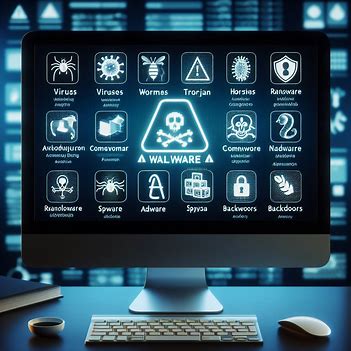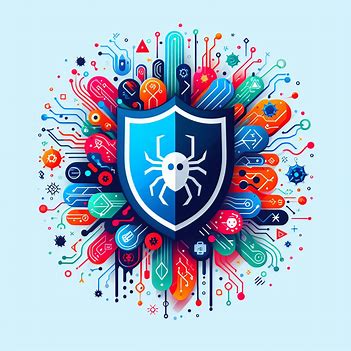Computer viruses and malware are types of malicious software designed to disrupt, damage, or gain unauthorized access to computer systems, networks, and data.
What is computer virus?

A computer virus is a kind of harmful software that sticks to another program, like a document. It can copy itself and spread when someone first opens it on their computer. For example, if you get an email with a bad attachment and open it, the virus can start working on your computer. Viruses can be really bad. They can mess up your files, make your computer slow, and even record what you type.
Bad people who do cybercrimes don’t always make new viruses. They focus on making more complicated and profitable threats. When people talk about “getting a virus” on their computer, they usually mean some kind of bad software. It could be a virus, computer worm, Trojan, ransomware, or something else harmful. Viruses and bad software keep changing and getting smarter, and cybercriminals use the ones that help them make the most money.
virus VS malware
Virus and malware are often used interchangeably, but they’re different. A computer virus is a type of malware, but not all malware are viruses.
virus
Think of a virus like a burglar sneaking into a house through an unlocked door. Once inside, the burglar hides and waits for someone to open the door again. Similarly, a computer virus needs someone to open a file or program to let it in.
Similarly, a computer virus:
- Relies on a host program to multiply.
- Needs human action to move from one device to another.
- Attaches its code to files or replaces them with copies of itself.
Viruses can sneak into a computer or system using different methods like phishing attacks, compromised web pages, or infected links. They can quickly spread and cause a lot of damage by messing up system files, wasting resources, deleting data, spreading spam, and causing chaos on devices and systems. Some viruses are even smart enough to change their code to hide from being detected.
Malware
Malware, short for malicious software, includes any harmful software that aims to damage computers or networks. Among the various types of malware, viruses are notable for their ability to reproduce and spread. However, not all malware are viruses, as the term “malware” encompasses a broader range of threats.
The difference between malware and viruses lies in their categorization: malware serves as a general term for harmful software, while viruses represent a specific type within this category. Therefore, whether malware is considered a virus depends on whether it displays typical virus traits, such as self-replication and spreading capabilities.
Other types of malware

Let’s take a look at various types of malware and how they operate, which can help you defend against attacks or remove threats from your device.
Ransomware
This malware locks you out of your device, files, and folders, demanding a ransom to regain access. It often asks for payment in cryptocurrencies like Bitcoin. Avoid paying the ransom and instead use free decryption tools to recover your files. Installing ransomware protection can help prevent future attacks. The WannaCry ransomware attack in 2017 infected many computers, including those in hospitals and public institutions.
Adware
Adware bombards your device with advertisements to boost ad revenue. Malvertising, a form of adware, can infect ad exchanges on websites, compromising security settings and injecting more dangerous malware onto infected websites. Adware can compromise your privacy and device performance. Use adware remover tools to target and eliminate the threat.
Spyware
This malware tracks user activity and logs behavior, including conversations, browsing habits, and sensitive information like credit card details and passwords. While similar to viruses in its potential harm, spyware usually requires action like clicking on a link to infect a system. Employ dedicated anti-spyware tools to identify and remove spyware.
Worms
Computer worms, like viruses, can self-replicate and spread across networks. However, unlike viruses, worms don’t need a host file to latch onto. They can exploit program vulnerabilities to spread automatically without human interaction.
Rootkit
Rootkits hide themselves or other malware deep within a system, making detection difficult for regular anti-malware software. They work silently in the background, causing gradual damage. Hackers use rootkit attacks to steal data, install malware, conduct spam or DDOS attacks, or gain remote access to a system. Rootkit scanner tools are crucial for detecting and removing rootkit threats.
Trojan
Trojans infiltrate devices disguised as harmless programs, exploiting security vulnerabilities to introduce additional malware. Unlike viruses, Trojans don’t self-replicate, but they’re often used by skilled hackers to facilitate the injection of more dangerous malware. Trojan attacks can be severe, so use Trojan scanner tools if you suspect an infection.
What type of devices can be affected?

Malware can affect various types of devices, but the level of risk varies depending on the device’s operating system and user behavior.
1. Windows PCs: These are the most common targets for malware because they are widely used. Malware creators often focus on Windows systems due to their popularity.
2. Mac computers: While Macs were previously less targeted due to their lower market share, they have become more vulnerable as their popularity has increased. Mac malware has started to emerge in recent years.
3. Smartphones and tablets: These devices can also be infected by malware, although they typically have higher security measures in place. iPhones restrict app downloads to the official App Store, while Android devices allow downloads from sources other than Google Play. However, both platforms can still be affected by malware if malicious apps manage to slip through the security checks.
4. Jailbroken devices: Jailbreaking removes the built-in protective measures of smartphones or tablets, making them more susceptible to malware. While jailbreaking is usually done by advanced users who understand the risks, it significantly increases the device’s vulnerability to malware.
In summary, Windows PCs are commonly targeted by malware, while Macs are becoming increasingly vulnerable. Smartphones and tablets can also be affected, especially if users download apps from unofficial sources or jailbreak their devices. Android devices are generally more prone to malware attacks compared to iPhones, especially if they are not downloaded from reputable sources like Google Play.
Solution for both malware and viruses

Instead of worrying about specific types of malware, focus on protecting your system from all threats with robust antivirus software. Avast One provides extensive detection and prevention against viruses, malware, spyware, ransomware, phishing, and more. With Avast One, you can trust in industry-leading antivirus protection to keep your system safe from a wide range of cyber threats.




Leave a Reply